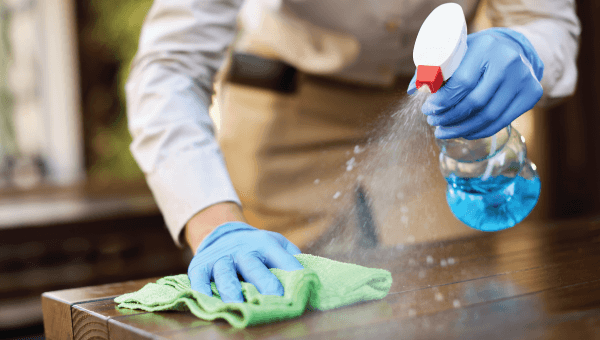
Understanding COSHH in Care Homes
In the dynamic environment of a care home, the safety and well-being of both residents and staff are paramount. One crucial aspect of ensuring a secure and healthy workplace is understanding and implementing COSHH (Control of Substances Hazardous to Health) regulations. In this article, we will delve into the key components of COSHH, with a specific focus on care home settings.
What is COSHH?
COSHH stands for the Control of Substances Hazardous to Health. It is a set of regulations designed to protect individuals from the harmful effects of exposure to hazardous substances. In a care home, these substances can range from cleaning chemicals and disinfectants to medicines and bodily fluids.
What Is An SDS?
SDS, or Safety Data Sheet, is a document that provides detailed information about a cleaning chemicals. It includes information on the properties of the substance, potential hazards, safe handling and storage procedures, emergency measures, and more. SDSs are crucial references for staff when working with chemicals in a care home.
Typical Control Measures
Implementing effective control measures is essential in minimising the risks associated with cleaning chemicals. These measures include proper storage of substances, use of personal protective equipment (PPE), adequate ventilation, and staff training. Regular risk assessments should be conducted to identify and address potential hazards.
.png)
Who Is Responsible For COSHH?
In a care home, the responsibility for COSHH compliance is shared among all staff members, from caregivers to management. However, there should be designated individuals responsible for overseeing COSHH implementation and ensuring that staff are adequately trained and informed.
Potential Exposures In A Care Home
Potential exposures in a care home can vary widely. Cleaning products, disinfectants, medications, and waste disposal are common sources of hazardous substances. Staff should be vigilant and follow proper procedures to minimise exposure risks, especially in areas such as kitchens, laundry rooms, and medical supply storage.

What Is PPE And How Does It Help?
PPE, or Personal Protective Equipment, includes items such as gloves, masks, aprons, and goggles. In a care home, PPE acts as a crucial barrier between staff and hazardous substances. Proper use of PPE significantly reduces the risk of exposure, protecting both staff and residents from potential harm.
How Often Should COSHH Reporting Take Place?
Reporting of incidents and potential hazards should occur promptly and consistently. Regular communication channels should be established, and staff should be encouraged to report any concerns immediately. This proactive approach ensures that issues are addressed promptly, preventing potential harm.
Where Can I Do My COSHH Training?
As part of our commitment to promoting safety and well-being in care homes, Gompels is pleased to offer free comprehensive COSHH Training on our website.
Why Choose Gompels for COSHH Training?
- FREE & Easy To Follow: Our COSHH training videos are developed in-house, with understanding of the unique challenges faced by care home staff. We focus on practical, real-world scenarios, making the training relevant to your daily responsibilities.
- Accessible Anytime: We understand the demands of a care home setting. Our training videos are accessible 24/7, allowing your staff to engage in learning at their convenience.
- Free Certification: Upon completing our multiple-choice questionnaire, we will email you a PDF certificate to show your training has been completed. This can then be revisited in 12 months to ensure you knowledge remains up to date.
Others also viewed
Hands-On Activity Ideas for Prehistoric Play and Learning
Here’s how you can use Yellow Door’s dinosaur-themed resources to create exciting learning opportunities in your setting.
How Trikes, Bikes, and Scooters Boost Early Years Development
Discover how trikes, bikes, and scooters can enhance early years development. Learn about the physical, cognitive, and social benefits these activities bring to your nursery setting.
8 Actionable Steps to Achieve an 'Outstanding' Nursery Rating
Discover actionable strategies from 2024's top-rated nurseries to help you achieve an 'Outstanding' Ofsted rating. Learn how to enhance staff interactions, curriculum, and more.
Understanding EN71 Testing And Craft Safety For Children Under 3
Discover how nurseries can safely incorporate Arts & Crafts for children under 3 with new childcare funding. Understand EN71 safety standards, why age warnings exist, and get practical tips for supervised craft activities.
Can Sun Cream Cause Prickly Heat Rash?
Learn how to prevent heat rash in children during hot weather, especially when using sun cream. This guide covers causes, symptoms, and practical tips for choosing the right sun cream and application techniques to keep...
Does closing the toilet lid when flushing reduce the spread of germs?
Discover the latest research on restroom hygiene practices in care homes, revealing the unexpected impact of toilet lid closure and the critical importance of using effective disinfectants like Soclean Antibacterial Washroom Cleaner for enhanced safety.
Red Sea Attacks: Shipping Updates
Red Sea Shipping Updates and what it means for our customers.
Why Log Reduction Matters For Surface Disinfection
The numbers associated with log reduction, such as 99.9% or 99.999%, might seem trivial, but they hold profound implications for the effectiveness of a disinfectant.
A Pioneering Approach to Reducing UTIs in Care Homes
In 2012/2013, urinary tract infections (UTIs) topped the charts for emergency hospital admissions. The culprit? Dehydration.
Direct Gloving vs Hand Hygiene Before Donning Gloves Study
The demands on healthcare personnel, such as time constraints, high workload, and understaffing, are major barriers to strict adherence to hand hygiene. The use of gloves, while common and increasing, poses another hurdle to infection control.











